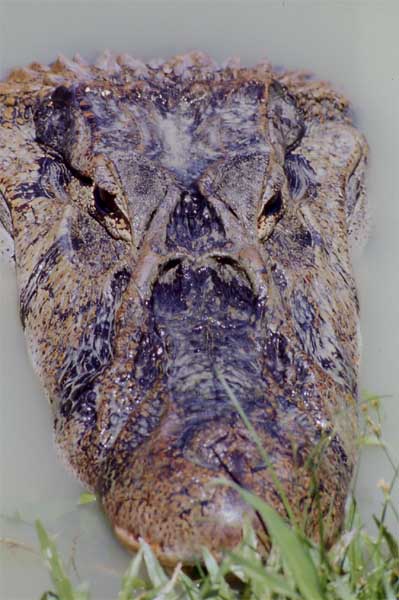 Caiman head peering out through the water.
Caiman head peering out through the water.
Image provided courtesy of Jungle Photos (www.junglephotos.com)
go to http://www.junglephotos.com/homepage/useterms.html for usage information
10/3/02: Information
on Fauna species in the rainforest
| Invertebrates | Ants: 30% of Amazon basin biomass.
Feed on leaves, tiny animals, grains, caterpillars, wood, etc. Function
as herbivores, scavengers, soild conditioners, predators. Their predators:
mainly anteaters and antbirds.
Butterflies: longwing, owl, clearwing hairy caterpillar, yellow caterpillar harlequin beetle katydids Spiders: golden orb weaver, tarantula wasps, mosquitoes millipedes, leeches, snails |
| Reptiles | Anaconda, black caiman, spectacled caiman, turtles, green iguanas, thorntailed iguanas |
| Mammals | Cats: 6 types in amazon:
jaguars, ocelot,
white-lipped peccary, collared peccary, 3-toed sloth, brazilian tapir Monkeys: monk saki, wooley monkey, saddleback tamarin, squirrel monkey, capuchin monkey, pygmy marmoset capybara, black agonti, manatee, giant anteater Bats: most insectivorous, some eat fruit, some carnivorous, some drink your blood Nearly half of amazon's mammal species are bats. tent making bat, bulldog bat, vampire bat |
| Birds | blue-yellow macaw, scarlet macaw-
eats clay, probably to reduce the harmful effects of poisonous substances
it ingests.
blue-headed parrot, orange winged parrot, mealy parrot white-throated toucan, yellow-ridged toucan Egret: 4 species of egret: great egret, great blue heron, paint-billed crake, harpy eagle, ferruginous pygmy owl, hoatzin, spix's guan, wattled curassow, gray-winged trumpeter, oropendulcas |
| Fish | Piranha: 12+ species, most eat
fallen fruit. Red-bellied piranha (the infamous species), white piranha,
silver dollarfish, thorny catfish, dogfish, oscarfish, pirarucu |
| Amphibians | strawberry poison dart frog, yellow and black poison dart frog, leaf toad, leaf frog, cane toad |
10/14-15/02
Interesting site I found, pertaining
to the Peruvian section of the Amazon: http://www.egallery.com/amazon.html.
This site discusses artists and their artwork of people indigenous to the
Amazon rainforest, incorporating native mythology as well as knowledge
of rainforest fauna and flora.
More information for the chart:
| Insects | hercules beetle (dynastes hercules):
six month adult lifespan, eat decayed fruit. 20 month larval cycle, eat
decayed wood. subfamily dynastinae has about 1800 species in Brazil.
wood-boring beetle (coleoptera cerambycidae): very harmful to host plants, often causing death; however, they greatly aid in recycling nutrients: holes they leave in the plants are entrances for cellulolytic fungi and bacteria, which can then decompose the plants quicker. There are about 10000 speices of family Cerambycidae. |
| Birds | Little blue macaw (cyanopsitta
spixi): only one left in the wild, 30 in captivity
blue macaw (anodorhynchus leari): about 60 left. occasionally sought for food or as pet. blue macaw (anodorhynchus glaucus): extinct blue macaw (anodorhynchus hyacinthinus): extremely hurt by deforestation and bird smuggling. Macuco (tinamus solitarius): about 52cm tall, weighing 1.2009-1.8009g. Tinamidae family gets tired easily due to blood vessel diameter. Macuco prefer clean woods but also found in irregular areas such as creeks, caves, and places of difficult access. Found all over eastern Brazil. Predators: gato-do-mato, foxes, guaxinins, furoes, opossums, iraras, hawks, and owls. One of the most hunted gamebirds in Brazil. Mutum-de-alagoas (mitu mitu): slightly larger than a domestic rooster. Limited habitat, so rare that for a while thought extinct in nature. |
| Mammals | Mico-leao-dourado (leontopithecus
rosalia): 25-35 cm in height, weighing about 600g. Threatened by smuggling
and habitat reduction. There habitat is currently limited to the
woods in the state of Rio de Janeiro. Protected by Federal Law No.
5.197 of Jan. 3, 1967.
sauim-de-coleira (saguinus bicolor): 117-336mm height, weighing 125-583g. Gives birth to one or two babies (false twins) 1-2 times a year. Distribution from Itacoatiara city to 40km north of Manaus. Eats insects and fruits, nectar and saps, lives in groups of 10, range of 12-21 ha. Macaco-bigodeiro (saguinus imperator): saguinus is the most diverse genus among neotropical primates, with 11 species and 30 recognized subspecies. saguinus imperator live in groups of 3-8. They weigh 400-500g, eat fruit, insects, and nectar. Located in primary and secondary forests in the state of Acre; in tropical forests north of Amazon river, and between Xingu River and Gurupi River in the south. |
 Caiman head peering out through the water.
Caiman head peering out through the water.
Image provided courtesy of Jungle Photos (www.junglephotos.com)
go to http://www.junglephotos.com/homepage/useterms.html
for usage information